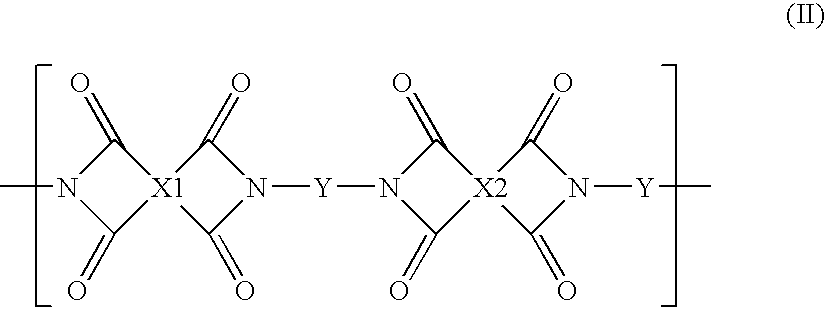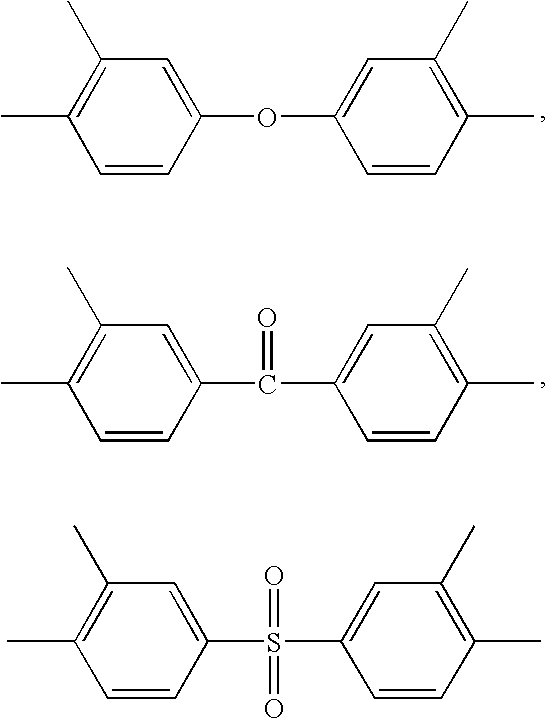High Performance Cross-Linked Polybenzoxazole and Polybenzothiazole Polymer Membranes
a polymer membrane and cross-linked technology, applied in the field of high-performance cross-linked polybenzoxazole and polybenzothiazole polymer membranes, can solve the problems of insufficient thermal stability and contaminant resistance of traditional polymer membranes, inability to meet the requirements of filtration, and inability to withstand high temperature and high temperature, so as to improve membrane selectivity and chemical and thermal stability, the effect of improving the selectivity and high selectivity
- Summary
- Abstract
- Description
- Claims
- Application Information
AI Technical Summary
Benefits of technology
Problems solved by technology
Method used
Image
Examples
example 1
Synthesis of poly(BTDA-APAF) polyimide
[0050]An aromatic poly[3,3′,4,4′-benzophenonetetracarboxylic dianhydride-2,2-bis(3-amino-4-hydroxyphenyl)-hexafluoropropane] (poly(BTDA-APAF)) polyimide containing UV cross-linkable carbonyl groups and pendent —OH functional groups ortho to the heterocyclic imide nitrogen in the polymer backbone was synthesized from 2,2-bis(3-amino-4-hydroxyphenyl)-hexafluoropropane diamine (BTDA) and 3,3′,4,4′-benzophenonetetracarboxylic dianhydride (APAF) in NMP polar solvent by a two-step process involving the formation of the poly(amic acid) followed by a solution imidization process. Acetic anhydride was used as the dehydrating agent and pyridine was used as the imidization catalyst for the solution imidization reaction. For example, a 250 mL three-neck round-bottom flask equipped with a nitrogen inlet and a mechanical stirrer was charged with 10.0 g (27.3 mmol) of APAF and 40 mL of NMP. Once the APAF was fully dissolved, a solution of BTDA (8.8 g, 27.3 mmo...
example 2
Synthesis of poly(ODPA-APAF) polyimide
[0051]The aromatic poly[4,4′-oxydiphthalic anhydride-2,2-bis(3-amino-4-hydroxyphenyl)-hexafluoropropane] (poly(ODPA-APAF)) polyimide containing pendent —OH functional groups ortho to the heterocyclic imide nitrogen in the polymer backbone was synthesized from 4,4′-oxydiphthalic anhydride (ODPA) and 2,2-bis(3-amino-4-hydroxyphenyl)-hexafluoropropane (APAF) in NMP polar solvent by a two-step process involving the formation of the poly(amic acid) followed by a solution imidization process. Acetic anhydride was used as the dehydrating agent and pyridine was used as the imidization catalyst for the solution imidization reaction. For example, a 250 mL three-neck round-bottom flask equipped with a nitrogen inlet and a mechanical stirrer was charged with 10.0 g (27.3 mmol) of APAF and 20 mL of NMP. Once APAF was fully dissolved, a solution of ODPA (8.88 g, 27.3 mmol) in 35 mL of NMP was added to the APAF solution in the flask. The reaction mixture was m...
example 3
Preparation of poly(BTDA-APAF) polymer membrane
[0052]The poly(BTDA-APAF) polymer membrane was prepared as follows: 4.0 g of poly(BTDA-APAF) polyimide synthesized in Example 1 was dissolved in a solvent mixture of 12.0 g of NMP and 12.0 g of 1,3-dioxolane. The mixture was mechanically stirred for 2 h to form a homogeneous casting dope. The resulting homogeneous casting dope was allowed to degas overnight. The poly(BTDA-APAF) polymer membrane was prepared from the bubble free casting dope on a clean glass plate using a doctor knife with a 20-mil gap. The membrane together with the glass plate was then put into a vacuum oven. The solvents were removed by slowly increasing the vacuum and the temperature of the vacuum oven. Finally, the membrane was dried at 200° C. under vacuum for at least 48 hours to completely remove the residual solvents to form poly(BTDA-APAF) polymer membrane.
PUM
| Property | Measurement | Unit |
|---|---|---|
| Temperature | aaaaa | aaaaa |
| Temperature | aaaaa | aaaaa |
| Temperature | aaaaa | aaaaa |
Abstract
Description
Claims
Application Information
 Login to View More
Login to View More - R&D
- Intellectual Property
- Life Sciences
- Materials
- Tech Scout
- Unparalleled Data Quality
- Higher Quality Content
- 60% Fewer Hallucinations
Browse by: Latest US Patents, China's latest patents, Technical Efficacy Thesaurus, Application Domain, Technology Topic, Popular Technical Reports.
© 2025 PatSnap. All rights reserved.Legal|Privacy policy|Modern Slavery Act Transparency Statement|Sitemap|About US| Contact US: help@patsnap.com



